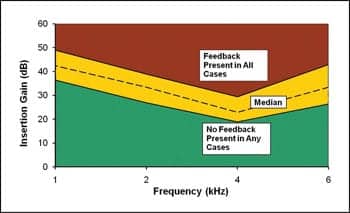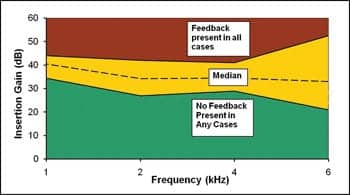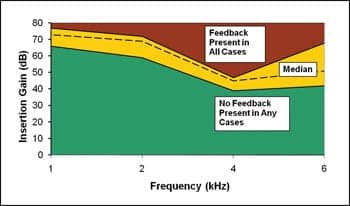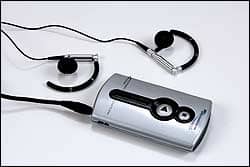A straightforward method for assessing frequency-specific feedback limitations.
The advancement of feedback suppression algorithms has extended the fitting range for open fittings, but feedback is still the major limiting factor for such devices. This study proposes a simple objective method to measure the frequency-specific maximum stable insertion gain capabilities of hearing aid coupling systems. The maximum stable gain was measured in three existing instant-fit coupling methods providing different levels of occlusion: A thin-tube vented dome; a thin-tube occluding dome; and a universal earmold with standard tubing. The occluding double dome was found to provide the most stable gain across all frequencies in average sized ear canals.

|

|
| Michelle Gray, MSc, is an audiological scientist, and Rhys Meredith, MSc, is head of audiology at ABM University Trust, Singleton Hospital, Swansea, England. | |
Most hearing aids fitted in the UK are prescribed by the National Health Service (NHS). NHS hearing aids are modern digital products, predominantly of the behind-the-ear (BTE) type. In recent years BTE hearing aids have shown a resurgence in popularity in the United States. This is thought to be due to a combination of factors including reduced occlusion effect, the appealing cosmetic appearance of thin tubes, and directional microphones.1 Figure 1 shows a hearing aid, with a typical thin-tube instant coupling system.
By eliminating the need for an earmold, instant fittings have the advantage of reducing waiting times and the number of clinic visits required. This has been seen as a particular benefit in the UK where reducing waiting times for NHS hearing aids is a priority.
The advancement of feedback suppression algorithms has extended the fitting range for open fittings.2,3 However, acoustic feedback is still an issue4 and is particularly relevant for hearing aid users with greater than mild-to-moderate levels of hearing loss. Therefore, instant fit solutions that are less susceptible to acoustic feedback are useful particularly when an open fitting is unsuccessful due to feedback.

|
| FIGURE 1. Danalogic 6070 instant-fit hearing aid system. |
Acoustic feedback occurs at any frequency where the gain equals or exceeds the attenuation present in the feedback pathway. Previous studies have reported the stable gain limits of various earmolds and open-fitting designs. A typical method used to measure maximum stable gain involves slowly increasing the overall hearing aid gain control to the point just below where feedback is detected, then measuring the insertion gain at that gain setting.5 The main limitation of this method is that it does not determine the frequency at which the maximum stable gain is reached, and therefore provides no information on how much stable gain is available within each individual frequency band.
Parker et al6 used a radio aid system and real-ear measurement techniques to measure the frequency-specific feedback transmission pathway and found that earmolds tend to allow less stable gain in the higher frequencies. With the advent of digital feedback detection algorithms in hearing aids, the frequency-specific feedback transmission pathway can now be recorded easily and efficiently without the need for complex test equipment.2 This could provide us with an effective method for objectively measuring the feedback limits of a variety of hearing aid systems in a frequency-specific format.
The purpose of this article is to evaluate and compare the frequency-specific feedback limitation performance of three instant-fit ear coupling options.
Methods

|
| FIGURE 2. Standard deviation of maximum stable gain measurements for the two hearing aids tested in order to select the final test aid. |
Evaluation of the repeatability of maximum stable gain calibration systems. The available feedback suppression algorithms demonstrate a wide range of performance.7 The feedback calibration systems of two different hearing aid types were evaluated to determine which had the least variability within a controlled condition.
A simple test apparatus was designed to approximate a hearing aid fitted to an adult human external ear canal. This consisted of a silicon impression, which was modified to simulate an earmold with a large acoustic vent and fitted to a model of an external ear with a plastic syringe to simulate an ear canal with a 2cc volume. Standard earmold tubing was used to couple the earmold to the hearing aid.
The repeatability of the feedback calibration systems of the following two hearing aids was measured using this apparatus.
- Hearing Aid A with corresponding proprietary fitting software.
- Danalogic 6070 (equivalent to a Pixel PL70D in the United States) with Aventa 2.4 fitting software.
The maximum stable gain was recorded 10 times for both hearing aids. The frequency-specific standard deviations for the Danalogic and Hearing Aid A are shown in Figure 2. The aim was to determine which system had the lowest test-retest variability. As shown in Figure 2, the variability was considerably lower for the Danalogic than the other aid. As the test apparatus and environment were controlled, the variability would appear to be due to differences in the feedback detection systems employed by the two hearing aids. Therefore, the Danalogic hearing aid was selected to measure the feedback performance of the three instant fitting options.
Measures of maximum stable gain of three instant-fit designs. Subjects consisted of eight audiologists working in the audiology department at Swansea NHS Trust. Maximum stable insertion gain measurements were obtained using three instant-fit couplings, fitted in turn, to one ear of each subject (with the exception of the double dome, which was measured in five of the subjects). The right or left ear of each subject was selected based on adherence to the following inclusion criteria:
- No history of ear disease;
- No occluding cerumen present (ie, obscuring <20% of the cross-sectional area of the ear canal); and
- Tympanometry within normal limits.8
Measurements were performed using the same Danalogic 6070 hearing aid with Aventa 4.2 fitting software. In order to relate the measured insertion gain levels to maximum stable real-ear insertion gain, real-ear measures were performed in each subject.
The real-ear insertion gain (REIG) was measured using a 65 dBSPL speech-shaped noise for both the vented dome and instant fit earmold couplings. The Danalogic aids were programmed according to the fitting software to provide 20 dB of gain. The difference between the gain estimated by the fitting software and the actual REIG was later used to correct the maximum stable gain estimated by the fitting software to calculate the real-ear maximum stable insertion gain.
The following three instant fit options were evaluated:
- Thin tube with a vented dome style ending (Figure 3a);
- Thin-tube and a double-dome ending (Figure 3b); and
- A universal earmold for greater levels of amplification (Figure 3c).

|

|

|
| FIGURES 3a-c. Three instant-fit hearing aid couplings: a) thin-tube vented dome; b) thin-tube double dome; and c) universal instant-mold coupling for greater amplification. | ||
The third instant-fit option, designed by ReSound, is an inexpensive, silicon-based universal ear coupling intended to provide an instant-fit alternative to thin-tube open fittings (Figure 3c). It can provide a temporary, or in some cases a permanent, alternative to a custom-made earmold. It can be coupled to either the right or left ear, and its size and shape make it suitable for most adult ears. It has a small built-in vent.
Results

|
| FIGURE 4. Maximum stable insertion gain with vented dome coupling. |

|
| FIGURE 5. Maximum stable insertion gain for universal instant mold coupling. |

|
| FIGURE 6. Maximum stable insertion gain with double-dome coupling. |
Figures 4 to 6 show the range of frequency-specific real-ear maximum stable insertion gain for the subjects using each of the three types of coupling. In each figure, the lower green area shows the frequency-dependent range of stable gain for which no feedback was found in any cases. The yellow center area shows the range of gain that occurred in some cases and, within this area, the dotted line shows the median gain values where feedback occurred in half of the cases. For levels of gain within or greater than the red area, feedback occurred in all cases.
As can be seen from Figures 4 to 6, the coupling method, which results in the highest stable insertion gain across the frequency range, is the thin-tube double dome (Figure 3b). At 1, 2, and 6 kHz, the median maximum stable gain levels were similar for the vented dome and the instant mold, although the latter had approximately 10 dB more stable gain at 4 kHz.
Discussion
The results of this study indicate that the double dome is able to achieve significantly more gain than the vented dome, and this extends considerably the potential fitting range of the thin-tube coupling systems.
It should be noted that this study had a relatively small number of subjects, all with average-sized ear canals. Therefore, the thin-tube domes were, in all cases, a good fit. The occluding double domes appeared to provide significant attenuation of the feedback pathway.
There are currently few sizes available in these tips, and they may be more prone to feedback in ears smaller or larger than average. Likewise, the instant molds are currently available in one size. Thus, it cannot be assumed that a double dome will definitely be a suitable alternative for those patients who are audiologically unsuitable for a vented option. It may be prudent to manufacture a customized earmold prior to the fitting appointment for such patients as a reserve option.
Where a thin tube is found to be unsuitable due to factors such as feedback, inappropriate fit, discomfort, or wax—and when there is no customized earmold available—the instant mold might, in light of its ability to provide extra stable gain at 4 kHz compared to a vented dome, provide a suitable temporary mold.
There is a wide range of hearing aid coupling options, and only three have been presented in this report. It would be useful to assess a wider range of instant-fit coupling options, and also to compare them to the performance of customized earmolds with different venting characteristics, including open molds.
Although the data obtained in this study relates to just one type of hearing aid, the results should be applicable to other types of hearing aids with similar coupling mechanisms. However, it should be noted that the compression characteristics of each hearing aid should be taken into account as this may have an impact on the probability of feedback at lower input levels.
Conclusions
BTE hearing aids have increased in popularity in recent years due, in part, to the benefits of instant-fit thin-tube coupling methods. As instant-fit aids are a relatively recent phenomenon, there is limited objective data available, which indicates a realistic fitting range without substantial risk of feedback. This study presents data that provides objective frequency-specific maximum stable gain levels for three instant fit couplings, which can then be used in turn to create predicted fitting ranges.
As there have been considerable advances in digital feedback system technology in recent years, it stands to reason that there will be further developments in the future. This will likely result in larger fitting ranges of instant-fit coupling solutions.
This study has introduced a simple and cheap method to measure maximum stable gain limits of any hearing aid system using equipment that is typically available in most hearing care clinics and offices. This method can be used to create local fitting ranges for the various hearing aids and fitting options required.
Citation for this article:
Gray M, Meredith R. Stable gain limits of instant-fit hearing aid couplings. Hearing Review. 2009;16(12): 16-19.
References
- Strom KE. The HR 2006 dispenser survey. Hearing Review. 2006;13(6):16-39.
- Kuk F, Ludvigsen C, Kaulberg T. Understanding feedback and digital feedback cancellation strategies. Hearing Review. 2002;9(2):36-43.
- Reber MB. Boundaries of real open fittings: clinical experiences. Hearing Review. 2006;13(2):44-47.
- Martin RL. Phase-cancellation feedback control: all hype aside, it’s a big step forward. Hear Jour. 2006;59(10):56-58.
- Kuk FC. Maximum usable real-ear insertion gain with ten earmold designs. J Am Acad Audiol. 1994;5(1):44-51.
- Parker DJ, Okpojo AO, Nolan M, Combe EC, Bamford JM. Acoustic evaluation of earmoulds in situ: a comparison of impression and earmould materials. Brit J Audiol. 1992;26(3):159-66.
- Freed DJ, Soli S. An objective procedure for evaluation of adaptive antifeedback algorithms in hearing aids. Ear Hear. 2006;27(4):382-398.
- Recommended procedure for tympanometry. Brit J Audiol. 1992;26:255-257.
Correspondence can be addressed to HR at [email protected] or Michelle Gray, MSc, at .





